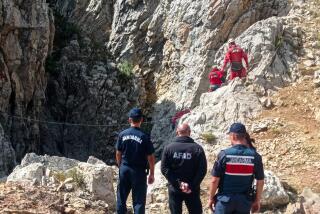Israel’s prehistoric Soreq Cave now a clean, eerily lighted place
SOREQ CAVE, Israel — This prehistoric cave on the slopes of Israel’s Judean Mountains has always felt a little otherworldly.
Like other dripstone caverns, Soreq Cave is packed with stunning natural sculptures formed by hundreds of thousands of years of mineral-rich water drops slowly leaving behind a rock residue.
On the roof is a hanging forest of different-sized rods, resembling icicles, giant carrots, elephant trunks and twisting octopus tentacles. Rising up to meet them from the limestone floor are 30-foot sand castles, spiraling rock towers and billowy hills that resemble coral reefs or heads of cauliflower.
As if it wasn’t strange enough, a recent ecological makeover has added a lighting system as spectacular as it is eerie.
Glowing amber spotlights fade into midnight blue mixed with circles of emerald, bathing the 50,000-square-foot cave and its formations in almost hallucinogenic color. Programmed to change every few minutes, the lighting turns a bright sunrise orange before slowly transforming into a deep purple.
“It’s like the cave is breathing,” said guide Boris Kripak, a Russian-born archaeologist who works at the cave, which was discovered in 1968 during rock-blasting for a nearby quarry.
The Hollywood-style lighting wasn’t installed for artistic or aesthetic reasons. Instead, the colors were selected as part of a decades-long ecological battle to keep the cave’s stalactites and stalagmites as pristine as possible.
By using only a limited part of the color spectrum of light and focusing on certain shades of orange, blue and green, scientists are betting the new system will eradicate one of the cave’s biggest threats: algae.
From the moment the cave was opened to the public in the 1970s, the introduction of white light, initially provided by automobile headlamps, triggered photosynthesis that led to the growth of algae.
Public use has also raised the temperature slightly and altered the all-important balance of carbon dioxide, said Tomer Saragusti, manager of the national Soreq Cave Nature Reserve.
“Just by opening the cave, we changed it and hurt it, so we’re always thinking about what’s best ecologically for the cave,” Saragusti said. “And it’s working. The cave is still alive and growing.”
If the algae were left unchecked, the magnificent formations — naturally amber, brown, rust and white — would turn into moss-covered green and black blobs.
If the scientists are correct, photosynthesis won’t occur if the traditional white lights, which contain all the colors of the spectrum, are replaced by cooler LED lights in limited hues.
It’s the latest volley in park officials’ war on algae. At first they tried limiting the use of lights, but with 200,000 visitors a year, there wasn’t much downtime.
Then they used ultraviolet light at night to kill the algae, but that left an unsightly soot-like residue that had to be cleaned. And eventually the algae developed an immunity to UV light.
“They call it a primitive plant, but algae is pretty smart,” Kripak said.
Finally, geologists found that they could remove the algae by painstakingly dabbing it with a bleach-soaked sponge on the end of a long pole.
Since the lighting system was installed this summer, cave officials have not noticed any new growth.
“We’re not popping the champagne, but we are not expecting to see any more algae,” Saragusti said. A similar system has proved effective at Crete’s Sfendoni Cave.
Park officials hired lighting designer Micha Margalit, whose work has varied from rock concerts to archaeological ruins, to decide where to position the lights and which formations to highlight. The formations are like a Rorschach test for visitors, who report seeing all kinds of things: people climbing a mountain, the Lion King, the U.S. Capitol, an ice cream cone, a woman carrying a baby on her back.
“I wanted to make it a show, so people would come in and say, ‘Wow,’” said Margalit, who spent hours in the cave staring at the shapes and following tourists around.
Initially he and park officials expected to mix all three colors together to create something that was as close to white as possible. But during some of the early previews for government officials and journalists, Margalit played around with the more dramatic coloring at the end of the tour, and it was so popular with visitors that it stuck.
Since unveiling the new lighting, the number of monthly visitors nearly doubled compared with the average in recent years.
Park officials had mixed feelings, worrying that the color display would distract from the natural beauty and scientific importance of the cave.
“We don’t want to turn the cave into a discotheque,” Kripak said.
Yet they decided to install audio wires with the lights, just in case they want to add the sound of, say, water dripping or music.
“It’s not exactly kosher,” Saragusti said. “But it’s what people expect.”
More to Read
Sign up for Essential California
The most important California stories and recommendations in your inbox every morning.
You may occasionally receive promotional content from the Los Angeles Times.










